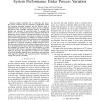Free Online Productivity Tools
i2Speak
i2Symbol
i2OCR
iTex2Img
iWeb2Print
iWeb2Shot
i2Type
iPdf2Split
iPdf2Merge
i2Bopomofo
i2Arabic
i2Style
i2Image
i2PDF
iLatex2Rtf
Sci2ools
ICCAD
2006
IEEE
2006
IEEE
Microarchitecture parameter selection to optimize system performance under process variation
Abstract— Design variability due to within-die and die-todie process variations has the potential to significantly reduce the maximum operating frequency and the effective yield of high-performance microprocessors in future process technology generations. This variability manifests itself by increasing the number and criticality of long delay paths. To quantify this impact, we use an architectural process variation model that is appropriate for the analysis of system performance in the earlystages of the design process. We propose a method of selecting microarchitectural parameters to mitigate the frequency impact due to process variability for distinct structures, while minimizing IPC (instructions-per-cycle) loss. We propose an optimization procedure to be used for system-level design decisions, and we find that joint architecture and statistical timing analysis can be more advantageous than pure circuit level optimization. Overall, the technique can improve the 90% yield frequen...
Architectural Process Variation | Hardware | ICCAD 2006 | Process Technology Generations | Process Variability |
| Added | 16 Mar 2010 |
| Updated | 16 Mar 2010 |
| Type | Conference |
| Year | 2006 |
| Where | ICCAD |
| Authors | Xiaoyao Liang, David Brooks |
Comments (0)

